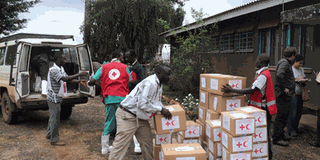Ebola: The fatal costs of a slow response

Uganda Red Cross personnel offloading health kits at Kagadi Hospital on Wednesday. The hospital at the heart of the Ebola outbreak is short of equipment to deal with the task at hand. Photos by Ronald Tumusiime/File
What you need to know:
The last Ebola scare was fairly quickly contained. This time round though, there have been lapses which have come with a high price.
One month after the death of the first Ebola victim at Kagadi Hospital – an infant whose family would lose nine members in all – the country’s hub for containing the deadly virus is still struggling to cope.
“The facilities are not okay,” says Steven Byaruhanga, the chairperson of the district Ebola taskforce. “The incinerators we don’t have… electricity is on and off, the pump for water is not functioning, the sewer system is also broken down, there’s so many problems.”
Patients at the hospital reportedly rioted on Tuesday, protesting the lack of food and clean water, while vehicles provided by the Ministry of Health sat idle for lack of fuel.
“There are so many cases reported but we could not move because there was no fuel,” Byaruhanga said.
“If we could get it, it could make the work so easy.”
No resources
Resources have been coming in piecemeal. According to Byaruhanga, World Vision this week donated 400 litres of fuel to fill in the gap, while Centres for Disease Control and the Red Cross have brought in thousands of protective suits. But as reports of suspected cases continue to increase into the district’s sub counties, a lack of the disposable wear has hindered containment efforts.
“At sub county health centres, we are getting reports that they are shying away from handling patients because they don’t have protective gear,” Byaruhanga said.
As of July 31, the ministry reported two new deaths for a suspected total of 16 people to have died from the fatal Sudan strain, diagnosed by the Uganda Virus Research Institute (UVRI) in Entebbe. The ministry said it is following up 176 people in total, to monitor for telltale symptoms of fever, vomiting, diarrhoea, severe blood loss and intense fatigue.
Meanwhile, traumatised health workers are being fast outpaced by what is being asked of them. Though they have been boosted by 100 Red Cross volunteers, MSF, CDC and WHO technical support, local NGOs and even private support, Byaruhanga says morale is low.
“Some of them are demoralised, others are stigmatised because their colleague has passed away,” he said. “They need at least some motivation, like some money to eat lunch.”
The district Ebola taskforce met on July 30, two days after the outbreak was publicly announced by the ministry, and came up with an emergency response plan, which Byaruhanga says asks for more than Shs800m to tackle the outbreak.
According to health ministry permanent secretary Asuman Lukwago, that budget is being considered by cabinet and the national taskforce chaired by Director of Health Services Jane Acheng, who assesses field needs daily.
“We are mobiliing funds,” Lukwago said. “We have money in our budget for emergencies.”
The ministry’s top bureaucrat says the financial year, which began in July, has opened up a Shs2.5b reserve fund which can be fronted by National Medical Stores to stem the crisis.
One outbreak to the next
The last Ebola scare was quickly contained, and the sole confirmed case of a 12-year-old girl dying in Luwero district, only 75km from the capital, did not spread.
When a Kagadi health worker was transferred and died at Mulago Hospital one week before the outbreak was even announced, officials there had no idea that Ebola was even a worry, Byaruhanga said.
But according to the ministry, the seven remaining health workers being observed there under isolation have not presented with any symptoms, and no new cases reported in the capital.
This delay was due in large part to the family’s spiritual beliefs.
“Losing three people in a day, people would think it is something strange and not normal, so they said this was because of the witch doctors,” Byaruhanga said.
“Actually, it blindfolded other research that would have taken place.”
Yet the western region is no stranger to Ebola – it last saw an outbreak in 2007 that killed 37 people in Bundibugyo District.
The Bundibugyo strain presented differently from the current and more common Sudan strain, Byaruhanga said, which for one, presents with symptoms of bleeding after, and not before death.
“We thought it was a strange disease because the symptoms first of all were not like one of the previous Ebola – that’s why people were not cautious about it,” he said.
Uganda’s first outbreak in the northern Gulu District in 2000 killed 224 people, with 425 infected – the largest documented Ebola epidemic so far.
That outbreak killed the renowned Dr Matthew Lukwiya, who was credited with saving hundreds of lives before becoming infected by the disease himself.
A vaccine is currently being developed by the Makerere University Walter Reed Project (MUWRP), the same group of experts working to develop an HIV vaccine.
Though it has been tested to be safe on humans, Dr Hannah Kibuuka, MUWRP director, says it is years away from being able to be used in an outbreak situation.
However, in a German biosafety laboratory in March 2009, a lab worker was accidentally exposed to the Zaire strain of the Ebola virus, and given an experimental vaccine that had never before been tested on humans.
Though scientists could not confirm if she had ever contracted the virus in the first place, it did her no harm and she survived.
According to Dr Gary Kobinger, the Canadian researcher who developed and provided her that experimental vaccine, having a backup option for outbreak situations is on the WHO agenda, and will be discussed at a meeting of Ebola and global health experts this September.




